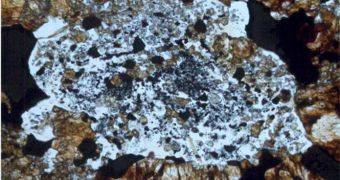After spending hundreds to thousands of years buried in the ground, and then an additional decades as a barbecue support, a fair attraction, and an object of study for students from two universities, a large rock was finally properly classified as a meteorite. The object weighs in excess of 40 pounds (18.1 kilograms), and it was discovered in a ditch back in 1999, as Donald Wesson and wife Debbie were driving in north central Oregon. The two picked it up and carried it home, but it wasn't until 10 years later that they realized what they had been keeping in their backyard.
Studies of the meteorite have revealed that the rock most likely traveled millions of miles throughout our solar system, and also that it must be several billion years old. Averaging about the size of a beach ball, the object is only the fifth meteorite found in the state of Oregon. “It was probably plowed up by a farmer and tossed to the side of the road. There is even evidence that the rock was hit by a plow,” says geologist Dick Pugh, who is based at the Portland State University, in Oregon. Wesson became interested in the history of the stone after watching a TV show about meteorites.
Last summer, he took the rock to a member of the Southern Washington Mineralogical Society, who referred the finding to the Bellingham, Washington-based Western Washington University. Experts here ran some tests, and determined that the rock was most likely a meteorite. Experts at the PSU Cascadia Meteorite Laboratory gave final confirmation, and said that the rock was highly shocked (S5) but minimally weathered (W1). They classified it as an ordinary chondrite (L6).
“The meteorite isn't significantly weathered, but it has a distinctive yellow tint caused by weathering unlike that seen in meteorites recovered from deserts in Africa or Antarctica. Also, it has beautiful shock veins and glass, caused by a major collision in space,” says PSU planetary scientist Melinda Hutson, who was a member of the team that looked at the rock. “Given the kind of meteorite that it is, and the shock effects that it experienced, it probably started its travels to Earth from the asteroid belt about half a billion years ago,” says another PSU science team member, Alex Ruzicka. He added that the stone most likely formed some 4.5 billion years ago, when the solar system appeared.
“In a way, I'm not surprised at all by this discovery. With our vigorous outreach effort I always knew the lab would help to recover more meteorites from Oregon, I just didn't know when. Maybe this will be the start of many more to come,” Ruzicka tells Space, referring to the small number of space rocks found in the state. The rate of discovery here is about 34 times lower than in Kansas, for example, where lighter-colored soils and the lack of forests make detection easier.

 14 DAY TRIAL //
14 DAY TRIAL //